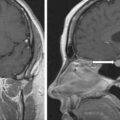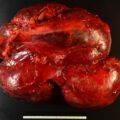Bilateral macronodular adrenal hyperplasia (BMAH) is an uncommon cause of adrenal hypercortisolism. It is a progressive disease that may present with a spectrum of cortisol and aldosterone secretion. BMAH can be sporadic or familial, usually due to germline pathogenic variants in armadillo repeat containing 5 ( ARMC5 ). ,
Case Report
A 66-year-old woman presented for evaluation of corticotropin (ACTH)-independent hypercortisolism. She was initially discovered with bilateral adrenal nodules during abdominal imaging performed for appendicitis. Following this incidental discovery, she was referred to a local endocrinologist who performed workup for adrenal hormone excess and diagnosed autonomous cortisol secretion.
Over the preceding 8–12 months, she had gained 30 pounds in weight, and her hypertension was more difficult to control, necessitating addition of another medication. Her hypertension was treated with lisinopril, hydrochlorothiazide, metoprolol, and amlodipine. In addition, she took 60 mEq of potassium per day for hypokalemia. She had dyslipidemia that was treated with simvastatin. On physical examination, her blood pressure was 142/72 mmHg and body mass index was 39.6 kg/m 2 . She had abdominal obesity but no supraclavicular or dorsocervical pads, no striae, no facial rounding, and no proximal myopathy.
INVESTIGATIONS
Autonomous cortisol secretion was confirmed, and case detection testing for primary aldosteronism was positive ( Table 20.1 ). Confirmatory testing for primary aldosteronism was not pursued. Abdominal computed tomography (CT) demonstrated bilateral macronodular adrenal hyperplasia ( Fig. 20.1 ).
| Biochemical Test | Result | Reference Range |
| 1 mg DST, mcg/dL | 14.7 | <1.8 |
| 8 mg DST, mcg/dL | 11.2 | <1 |
| ACTH, pg/mL | <5 | 7.2–63 |
| DHEA-S, mcg/dL | 26 | <15–157 |
| Aldosterone, ng/dL | 11, 13 | <21 |
| Plasma renin activity, ng/mL per hour | <0.6 | 2.9–10.8 |
| Urine metanephrines, mcg/24 h | 51 | <400 |
| Urine normetanephrines, mcg/24 h | 273 | <900 |
| Urine free cortisol, mcg/24 h | 8 | 3.5–45 |
| Midnight salivary cortisol, ng/dL | 172 | <100 |
Stay updated, free articles. Join our Telegram channel

Full access? Get Clinical Tree








